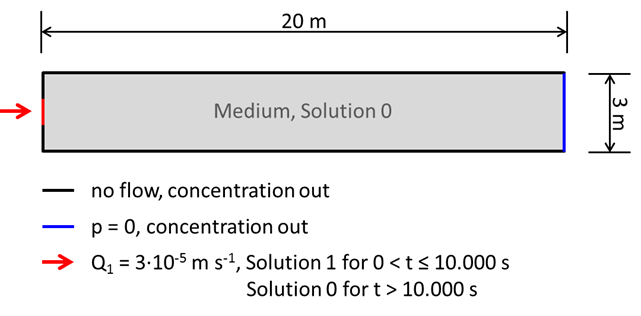Comparative calculations with PHAST (Parkhurst et al., 2010) and d3f++ (Schneider, 2016) were performed in order to evaluate the smart Kd-concept and to qualify its implementation in the code d3f++.A simple 2D testcase depicted in Fig. 1 with a near-equilibrium solution was used in the first step to test the smart Kd-concept against the full geochemical model (Noseck et al., 2018). For the first 10,000 s model time, the inflowing solution contains certain radionuclides. Apart from that, its composition remains constant over time.
Fig. 1: Model setup for the verification calculations (Noseck et al, 2018).
The spatial distribution of the radionuclides after 100,000 s model time shows a good agreement between the results obtained with PHAST (dashed) and d3f++ (solid) for the tracer (Fig. 2). The curves for the radionuclides differ slightly in position and height of the peak. For Ni and Np the difference seems acceptable but for Uranium the deviation is larger. However, recent changes in the smart Kd-concept and adjustment of the smart Kd-matrix resulted in a better agreement (to be published). A full description of the verification calculations can be found in Noseck et al (2018).
Fig. 2: Spatial distribution of the tracer and certain radionuclides after 100,000 s simulation time.
Contact: Anne Gehrke
References:
Noseck, U., Brendler, V., Britz, S., Stockmann, M., Fricke, J., Richter, C., Lampe, M., Gehrke, A., Flügge, J.: Smart Kd-Concept for Long-term Safety Assessment – Extension towards more Complex Applications, Final Report GRS-500, BMWi-FKZ 02E11072A and 02E11072B, Gesellschaft für Anlagen- und Reaktorsicherheit (GRS) gGmbH, Braunschweig (2018), 346 p.
Parkhurst, D.L., Kipp, K.L., and Charlton, S.R., 2010, PHAST Version 2 - A program for simulating groundwater flow, solute transport, and multicomponent geochemical reactions: U.S. Geological Survey Techniques and Methods 6–A35, 235 p.
Schneider, A. (ed.), Modelling of Data Uncertainties on Hybrid Computers, GRS-392, BMWi-FKZ 02E11062A, Gesellschaft für Anlagen- und Reaktorsicherheit (GRS) gGmbH, Braunschweig (2016) 187 p.

